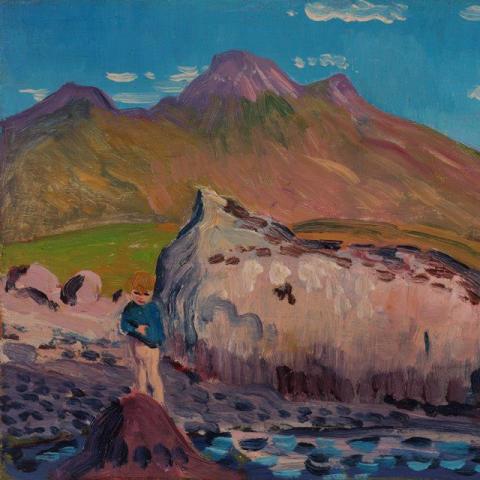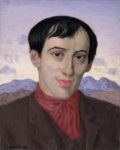
James Dixon Innes
British, 1887-1914
Tan-Y-Griseau, 1912
oil on board
30 1/4 x 40 in.
SBMA, Gift of Mary and Will Richeson, Jr.
1997.71.7

Innes in undated self-portrait.
COMMENTS
James Dickson Innes (27 February 1887 – 22 August 1914) was a British painter, mainly of mountain landscapes but occasionally of figure subjects. He worked in both oils and watercolours.
Of his style, art historian David Fraser Jenkins wrote: "Like that of the fauves in France and the expressionists in Germany, the style of his work is primitive: it is child-like in technique and is associated with the landscape of remote places."
James Dickson Innes was born on 27 February 1887 in Llanelli, in south Wales. His father, John Innes, who had come from Scotland, was an historian and had an interest in a local brass and copper works; his mother was of Catalan descent. He had two brothers, Alfred and Jack.
His parents sent him to be educated at Christ College, Brecon. Afterwards he studied at the Carmarthen School of Art (1904–05), from where he won a scholarship to the Slade School of Art in London (1905–08). His teachers at the Slade included P. Wilson Steer.
From 1907 he exhibited with the New English Art Club; and in 1911 he became a member of the Camden Town Group. The Camden Town Group included Walter Sickert who was an influence on Innes's art, and Augustus John with whom Innes became friends.
In 1911 he had a two-man exhibition with Eric Gill at the Chenil Gallery, London: "Sculptures by Mr Eric Gill and Landscapes by Mr J. D. Innes".
The Welsh politician and philanthropist Winifred Coombe Tennant (1874–1956) was an important patron of his work.
In 1913 Innes exhibited in the influential Armory Show in New York City, Chicago and Boston.
In 1911 and 1912 he spent some time painting with Augustus John around Arenig Fawr in the Arenig valley in North Wales; but much of his work was done overseas, mainly in France (1908–1913), notably at Collioure, but also in Spain (1913) and Morocco (1913) – foreign travel having been prescribed after he was diagnosed with tuberculosis. Eventually, on 22 August 1914, at the age of twenty-seven, he died of the disease at a nursing home in Swanley, Kent.
Innes was unusual for a British artist of that time, because of his bold painting style, more attuned to the French post-impressionists. It has been argued his unusual style led the way for British artists such as David Hockney.
In 2014 an exhibition of Innes' works was staged at the National Museum of Wales, Cardiff.
http://alchetron.com/James-Dickson-Innes
Welsh painter. He studied first at Carmarthen Art School, and then at the Slade School of Fine Art, London, from 1906 to 1908, where he met Derwent Lees (1885–1931). Innes made several trips abroad in order to paint, most importantly to Collioure, France, in 1908, and again in 1911. He is, however, best known for his paintings of Wales. In 1907 he had begun a friendship with Augustus John, whose fascination with gypsies had drawn him to Wales and to a nomadic life. With John and Lees, Innes wandered over a remote and unfashionable part of North Wales in pursuit of a romantic freedom; Innes slept out of doors despite the fact that he had been diagnosed as a consumptive.
Using a notational method and painting for the most part on a small scale, as in Bala Lake (c. 1911; Manchester, C.A.G.), he developed a style notable for its lucidity and immediacy of touch. He is most often associated with the mountain he painted repeatedly, Arenig (c. 1911–13; Cambridge, Fitzwilliam), on the top of which he buried a casket of love letters from Euphemia Lamb. He painted at speed, using chopped brushstrokes to render foliage, clouds or light reflections on water. His career was cut short by his tuberculosis.
Bibliography
James Dickson Innes (exh. cat., intro. J. Hoole; Southampton, C.A.G.; Cardiff, N. Mus.; London, F.A. Soc.; Manchester, C.A.G.; 1978)
Some Miraculous Promised Land: J. D. Innes, Augustus John and Derwent Lees in North Wales, 1910–12 (exh. cat., Llandudno, Mostyn A.G., 1982)
J. D. Innes, 1887–1914 (exh. cat., essay by C. Hampton; Llanelli, Pub. Lib., Nevill Mem. Gal., 1987)
- Frances Spalding, Grove Art Online, www.groveart.com
SBMA CURATORIAL LABELS
Plagued by consumption for much of his short life, Innes loved his native Wales, spending the summer of 1912 at Nant-Ddu in the company of Augustus John and Derwent Lees, friends he had made at the Slade School several years previously. John described how Innes would stride off into the landscape early in the morning and would return with three jewelled panels in the evening.
- British Modernism from Whistler to WWII, 2016
